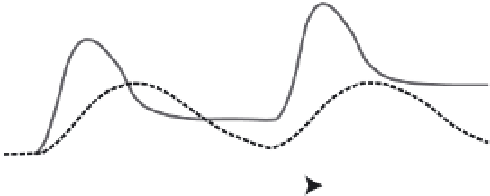Geology Reference
In-Depth Information
the sensitivity of faults to small changes in loads,
spatial and temporal changes in the locus and/
or rates of bedrock erosion in a mountain belt
due to climate variability might also modulate
fault slip rates. Given the striking correlation of
seasonal cycles of monsoon-modulated water
loads in the Himalayan foreland (see Box 5.2)
with both Himalayan seismicity and convergence
rates (Bettinelli
et al.
, 2008), these proposed
linkages between climate and fault slip rates at
intermediate time scales make conceptual sense.
Nonetheless, more high-resolution data are
needed at these time scales to explore the
characteristics of such potential linkages.
Because plate convergence rates can be as
high as 100 km/Myr, unsteadiness in conver-
gent processes should be well expressed at
intermediate times scales. For example, geo-
morphic studies along subduction zones have
shown that, when seamounts or a rough sea
floor impinge on a trench, the forearc deforms
(Fisher
et al.
, 1998). But, can the timing, wave-
length, and magnitude of that deformation
provide insight into the tectonic processes and
kinematics that govern the collision? Again,
competing models (Taylor
et al.
, 2005) make
contrasting predictions for the pattern and rates
of deformation at intermediate time scales
(Fig. 9.3). If a seamount that is rafted along by
a subducting plate steadily slips beneath the
forearc, it should generate a migrating wave of
forearc uplift and subsidence at spatial and
temporal wavelengths that scale with the size
of the seamount and the convergence rate. In
contrast, if the seamount gets stuck against the
forearc, collisional stresses could be abruptly
transferred to the outer forearc and might drive
rapid uplift above a subduction zone that
had become temporarily locked. If the plate
interface eventually ruptures through the sea-
mount, the release of those stresses could drive
rapid subsidence. These different forearc
behaviors can be assessed with data gathered
at intermediate time scales.
In this chapter, two different aspects of
tectonic geomorphology at intermediate time
scales will be examined. First, techniques for
calibration of rates of deformation are illustrated
by focusing on the use of various types of
Colliding
Seamount
Displacement
Model
sequential
uplift
slipping
interface
Compression
Model
differential
uplift
slipping
interface
locked
interface
Uplift
Patterns
collision 1
collision 2
compression
displacement
Time
Fig. 9.3
Models of forearc deformation for a
subducting seamount.
Colliding seamount (top), representing thickened crust,
approaches the forearc, where its collision could
cause distinctive patterns of deformation. In the
“displacement model,” the seamount slides beneath
the forearc, thereby driving accelerated uplift that
migrates landward and gradually decelerates in its
wake. In the “compression model,” the seamount gets
stuck as it impinges on the trench and forearc. The
locked interface translates the collisional stresses
inland and initially causes abrupt and rapid uplift.
If the locked interface then ruptures and dismembers
the seamount, subsidence will also be rapid. Each
model predicts a different temporal and spatial
pattern of uplift (bottom). Modified after Taylor
et al.
(2005).


























































































